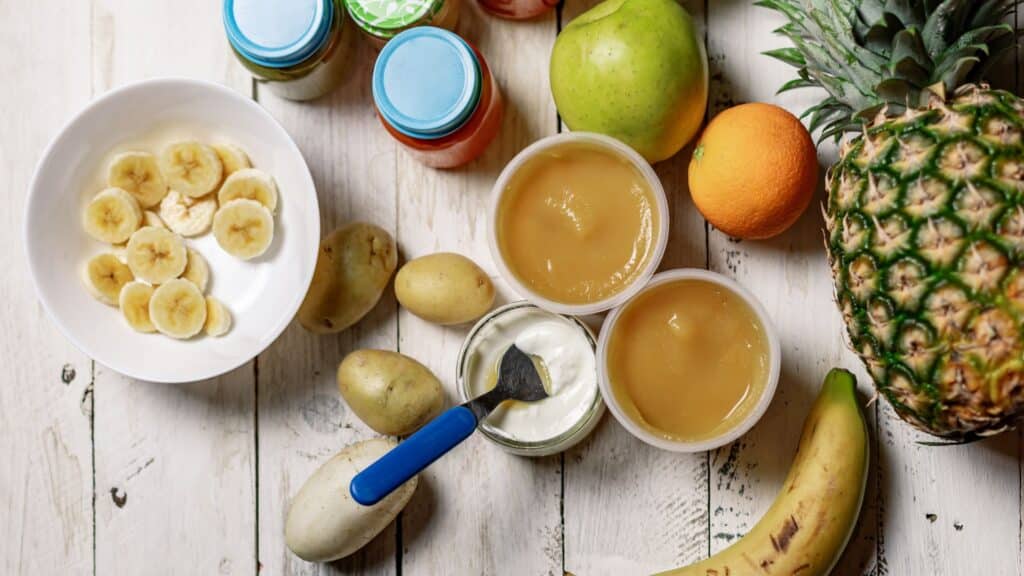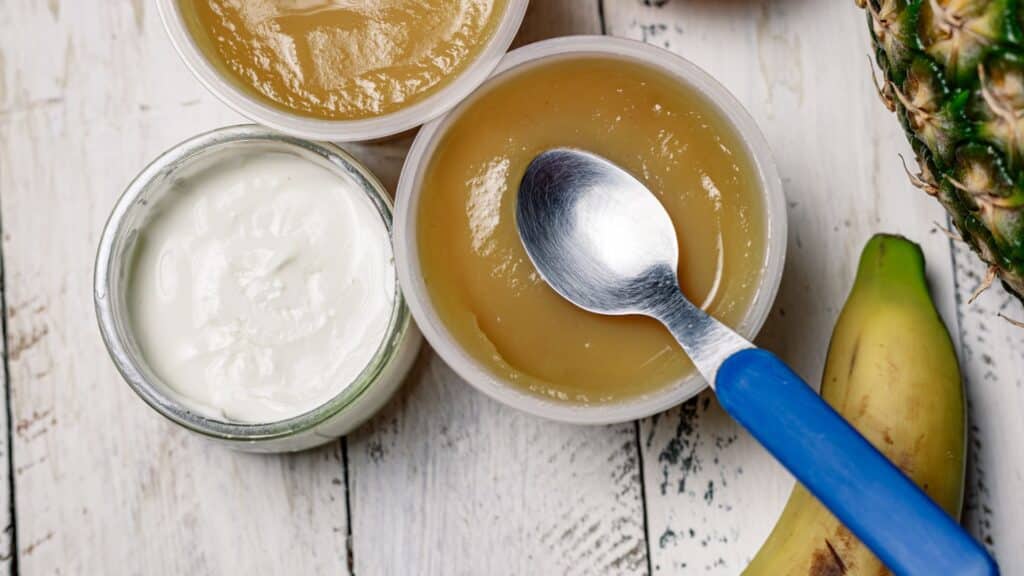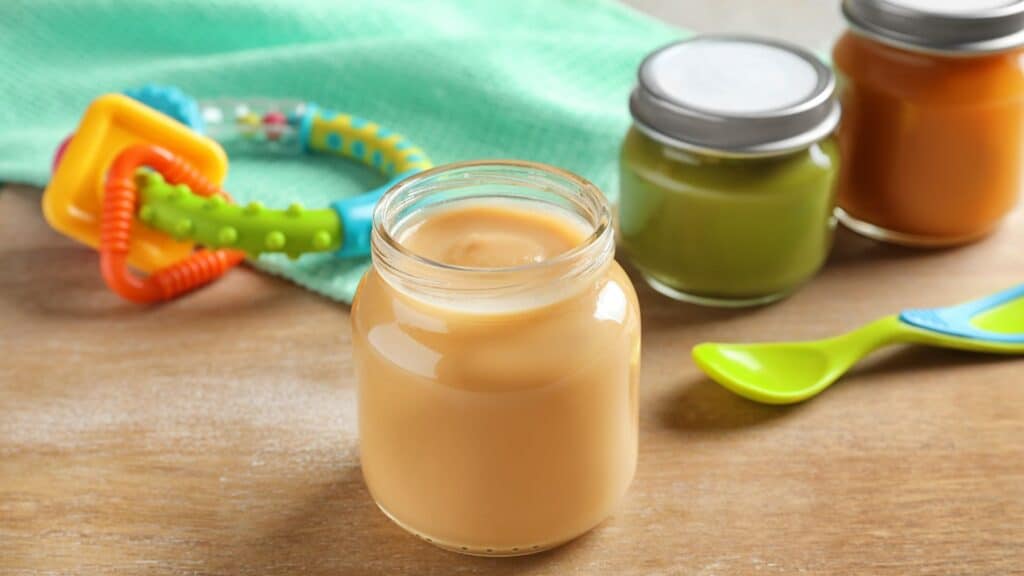Breastfeeding is highly recommended for infants as their baby food. After which, you may consider speaking with your pediatrician to know the best time to start your baby with solid foods.
Once your baby is ready, you’ll have plenty of store-bought baby food options at the supermarket to feed your baby. But did you know it’s possible to make homemade baby food at home?
Preparing homemade baby food offers your baby more variety than the ones you see in a store. Not only can you choose various foods and vegetables as ingredients, but you can even use frozen fresh purees or jarred baby food stored in their juices.
So, if you’re ready to try something new, continue reading. You can follow these guidelines to help you make the best homemade baby food for your baby.
Let’s get started!

Introduction to Homemade Baby Food
If you’re interested in making homemade baby food but don’t know where to start, don’t fret. What’s great about making it is that you only need a handful of items you can already find at home.
For starters, you can always use a potato masher or a fork in the making. It’s highly effective, especially when mashing bananas and baked sweet potatoes. You can also chop up other healthy foods, such as cooked eggs or fish, into small pieces that your baby can easily swallow.
But to make things easier, you may consider investing in various kitchen tools such as a food processor, food mill, or blender. These gadgets are highly efficient when turning cooked foods into baby purée.

Benefits of Homemade Baby Food
You’ll Know the Ingredients
When making your own baby meal, you’ll know exactly what you’re putting in and what you’re feeding your baby. It’s an excellent choice for parents who are picky with what they feed their children.
A More Economical Choice
Making homemade baby meal is much more economical than buying the ones in a store. That’s because you can choose where you source your ingredients and adjust the number of ingredients you need.
You Can Choose Your Ingredients
You can choose the vegetables, fruits, and other foods you want when making your own baby food [1]. It’s an excellent choice, especially if you want to try new things for your growing baby. After all, not every possible food combination can be available in the baby food section in your area.
It Lets Your Baby Try Out the Same Food as What You’re Eating
Lastly, you can let your baby eat the same food you’re eating in purée form. However, you must ensure that your homemade baby food doesn’t contain added sugar or salt to keep your baby safe.

Making Your Own Baby Food
Clean Your Kitchen
When preparing homemade baby food, you must ensure that your workstation is clean and free of dirt. Also, you need to sanitize your hands using soap and water before making homemade baby food. You must also rewash your hands when touching raw fish, meat, or eggs.
It’s also best to only use clean utensils and work surfaces as if preparing your own food. Meanwhile, if you’re sampling the baby food while preparing them, use a clean spoon or wash it off every time you taste them.
Prepare Your Ingredients
There are various ways to prepare your ingredients, depending on their type:
- Grains and cereals: You need to cook grains based on the instructions printed on the package. Meanwhile, if you’re introducing rice cereal or grains, you may consider serving it with milk formula or breast milk to make it soft enough for your baby to eat.
- Fruits and vegetables: Depending on what you’re planning to serve your baby, you may consider baking, boiling, or steaming them before grinding or puréeing them. For instance, you may boil mild yellow or orange vegetables such as carrots and sweet potatoes to make them soft. You may also do the same for green vegetables such as string beans.
- Meat and poultry: Make sure to cook meats and poultry before puréeing them or mashing them. A few of the most common choices for homemade baby food are chicken, beef, and lamb.
Add Flavor
Although it’s always best to serve unseasoned foods at the start, it doesn’t mean that you can’t try out new ways to add a bit of flavor when making baby food. If you want to add something new to your baby’s diet, consider using healthy herbs to give it a unique taste.
You may consider herbs such as cinnamon in your homemade baby food. You can also consider mixing two types of fruits and turning them into baby food purée to make it sweet.
Safely Serve and Store
Ensure you don’t let your baby’s food stay out for more than an hour at room temperature to prevent spoilage. Also, keep your cold foods cold and warm foods warm. But if you’re in doubt about its freshness, then consider disposing of it.
Also, make sure that dairy products such as milk and cheese are pasteurized. Remember that foods tagged as “raw” may contain bacteria that can cause infections. Foods such as raw or undercooked eggs may have salmonella. So, use pasteurized eggs with your baby’s food to be safe.

What You Need to Remember When You Store Homemade Baby Food
You can store homemade baby food in the fridge for two days until you get frozen cubes. You can also place the baby food purees for up to two months. Consider using a clean spoon when putting them in a single-serving airtight container or even put them on an ice cube tray so that you can easily prepare them if needed.
On the other hand, you may also heat leftovers on the stove when preparing your own baby food. Stir it for a bit while letting it sit for 30 seconds. Make sure to test the temperature before serving it to your baby. You may then store baby food leftovers afterward inside the fridge with a lid or plastic wrap.
In-Depth Guide to Preparing Homemade Baby Food
Wash and Peel
Wash and peel the fresh produce before making your own baby food. Also, get rid of all the pits and seeds before mashing them. You also need to wash fruits thoroughly and produce that grows close to the ground to prevent any potential contamination of Clostridium botulinum and other bacteria that may result in food poisoning.
Let the Ingredients Tenderize
Wait for the ingredients to get tender. When cooking your food, it’s always best to wait until it’s tender before putting it inside the food processor. You should also use as little water as possible when steaming and microwaving baby food ingredients to keep the nutrients and minerals intact. Also, remove any gristle, bones, and skin before cooking meat and fish.

Use the Fruits and Vegetable Juice
Use its juice when making jarred baby food. When making baby food purees, it’s highly advisable to use their juice instead of adding more sugar. Never attempt to add honey to their baby food purees to prevent Clostridium botulinum spore contamination. It’s also best to avoid adding corn syrup and artificial sweeteners to prevent excess calories.
Get the Right Texture and Temperature
Make sure that the baby food is at the right texture and temperature. Remember that foods like whole grapes, butternut squash, and other vegetables can be choking hazards, especially for infants. So, it’s best to mash or blend them when making your own baby food. You can thin out pureed foods such as sweet potatoes by adding formula, breast milk, or distilled water.
Cook Meats Thoroughly
Cook poultry and meat products well. Ensure that all the poultry and meat products used for the baby food are cooked thoroughly to protect your child from food poisoning. 145°F for fish, whole cuts of beef and pork, 160°F for ground beef and egg dishes, and 165°F for all fowl, poultry, and leftovers.
Freeze Leftover Baby Foods
Freeze any unused homemade baby foods. When making your own baby food, you can store any unused ingredients by freezing them in small portions. Once the baby food purées have all been frozen, you can put them in airtight, freezer-safe containers until you’re about to put them in the food processor.
Separate Your Baby’s Portion
Remove your baby’s portion from your own food before adding salt and other types of seasoning. Remember that a baby’s taste buds are still developing. It might still be sensitive to particular tastes, especially if it’s salty. So, separate your baby’s portion before adding any seasoning to your food.

Essential Tips When Making Baby Puree
Making smooth baby puree from sweet potato, frozen peas, and ripe bananas is easy to make baby food for your child. After all, all you need is to put them in a food mill or food processor until they reach the right baby food consistency. But did you know that there are a few things that you need to remember when you make your smooth puree?
Strain the Food
One of the first things you need to do when making smooth purees is strain the ingredients. Doing so will make it easier for you to remove any stray peels that might have been left over when you were cooking the food in the steamer basket. But you can skip this step by taking off the peels before cooking the food.
Put Them in an Ice Cube Tray
As previously mentioned, putting homemade food puree like butternut squash in the fridge overnight using freezer trays is an effective way to introduce solid foods to your growing baby. However, you must remember to thaw them in a basin of warm water in the fridge or the microwave. You can either serve frozen purees or solid food at room temperature or slightly warmed when you make baby food.
Stir Well When Serving Warm Baby Food Recipes
If you’re planning to serve homemade puree warm, stir it well before giving it to your baby. Also, it’s best to let it cool slightly until it’s cool enough for your baby to eat. You can check the temperature before serving it to avoid burning your toddler’s mouth.
Remember that heated food may have hot spots (especially if microwaved). So, stir the food well and wait 30 seconds until it’s baby ready.
Consider Using Frozen and Canned Ingredients
Most canned or frozen products are made from fresh foods picked during their peak freshness. So, use it for your puree, especially if fresh goods aren’t available.
You can also add breast milk or formula to achieve your desired consistency. Liquids can help you produce thinner purees, which are excellent for spoon-feeding your baby.

What to Expect from Baby-Led Weaning
Baby-led weaning is an increasingly popular way for parents and caregivers to start their babies with solid food. It primarily involves giving babies finger foods instead of starting with purees.
It started gaining traction in the U.K. and has become popular in the United States. The practice starts at around 6 months and older and jumps straight into finger foods while bypassing mashed-up foods.
This feeding technique allows self-feeding for the baby as they learn how to chew and swallow. It also prevents parents and caregivers from pushing food into the baby’s mouth since babies control the volume of food they want to eat.
Benefits of Baby-Led Weaning
Lets Babies Discover Various Textures and Flavors Independently
Allowing your babies to eat independently helps them develop their food preferences in the long run. However, you need to remember that certain foods like nuts and kinds of seafood may trigger allergic reactions. So, asking your doctor before giving them chopped foods is best.
Reduces the Chances of Obesity
Babies that are weaning independently learn how to regulate how much they eat based on their hunger level. Compared to spoon-feeding with homemade food, parents are in control, making babies eat faster and more than they need. This could result in the baby developing unhealthy eating habits, causing them to become overweight in the long run.
Refines Their Motor Skills
When babies start learning to self-feed, they will begin developing their fine motor skills and dexterity. That’s because eating finger foods encourages them to use their hand-eye coordination skills, especially when they’re eating new food.

Summary
These are only a few things you can always use as a guide to homemade baby foods. Remember that introducing solids can be challenging, especially if your baby isn’t used to them. So, always be patient as you make your own baby food and see how it goes!
Thanks for reading! If you have any questions, leave a comment below and we’ll be glad to help.



